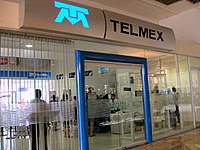Telecommunications in Mexico
| Telecommunications | |
|---|---|
 |
|
| Telmex Retail Store in Puerto Vallarta | |
| Telephone land lines | 19.8 million (2011) |
| Mobile lines | 94.5 million (2011) |
| Telephone country code | + 52 |
| Internet Users | 31 million (2009) |
| Internet country code | .mx |
Communications in Mexico are regulated by the Secretariat of Communication and Transportation (Secretaría de Comunicaciones y Transportes or SCT), a federal executive cabinet ministry and by the Federal Telecommunications Institute (Instituto Federal de Telecomunicaciones or IFT).
Mexico's communication services market is among the largest in Latin America, liberalized in the 1990s, with the landmark privatization of Teléfonos de México (Telmex), a previously state-owned monopoly. Since then, new operators have entered the market, but Telmex still remains the dominant player.
Founded on 13 May 1891, as the Secretariat of Communications and Public Works, the SCT is divided into three subsecretariats: the Subsecretariat of Infrastructure, the Subsecretariat of Communications and the Subsecretariat of Transportation.
The SCT has ceded many of its regulatory functions to the Federal Telecommunications Institute.
Usage of radio, television and Internet in Mexico nowadays is prevalent. The first television transmission in Mexico was conducted by Javier Stavoli in 1931. Guillermo González Camarena built his own monochromatic camera in 1934, and in 1940 he developed the first trichromatic system and obtained the first patent for color television in the world. After developing radio and television stations, in 1948, he built the studio Gon-Cam, which was considered the best television system in the world in the time, according to survey conducted by the Columbia College of Chicago.
With the passage of the century, the television broadcasting market became dominated by two powerful companies, Televisa—the largest Spanish media company in the Spanish-speaking world — and Azteca, even though several dozen regional networks operate in the country. In addition, many states have their own television networks, and public television has increased its market penetration in recent years. In 2014 there were 1,762 radio stations and 1,063 separately licensed analog and digital television stations.
...
Wikipedia
